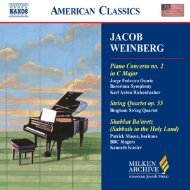Download Liner Notes PDF - Milken Archive of Jewish Music
Download Liner Notes PDF - Milken Archive of Jewish Music
Download Liner Notes PDF - Milken Archive of Jewish Music
Create successful ePaper yourself
Turn your PDF publications into a flip-book with our unique Google optimized e-Paper software.
appropriate for the American Reform worship<br />
format. Many congregational tunes that eventually<br />
predominated for decades in synagogues throughout<br />
America, orthodox and traditional as well as Reform,<br />
thus entered the American <strong>Jewish</strong> consciousness as a<br />
result <strong>of</strong> Binder’s efforts on this 3rd edition. These<br />
tunes included the most ubiquitous and once nearly<br />
exclusive versions <strong>of</strong> adon olam and ein keloheinu (the<br />
mistakenly so-called Freudenthal melody, after the<br />
organist and choirmaster in Braunschweig, Germany,<br />
who first printed and perhaps adapted—but did not<br />
compose—the tune in that synagogue’s hymnal in<br />
the 1840s). The Union Hymnal thus constituted a<br />
watershed event in the musical development <strong>of</strong> the<br />
Reform movement, giving it (or restoring) its musical<br />
roots; and it also had a ripple effect among American<br />
Jewry in general.<br />
Binder was appointed to be the consultant on <strong>Jewish</strong><br />
music for the United States Armed Forces Hymnal,<br />
which was prepared for servicemen during the Second<br />
World War. Published in 1941, it included appropriate<br />
hymns for the three principal American faiths:<br />
Protestant Christian, Roman Catholic, and <strong>Jewish</strong>.<br />
As a composer, Binder is remembered chiefly for his<br />
numerous liturgical choral settings, which include<br />
many individual prayers as well as entire services.<br />
Some <strong>of</strong> his once-popular earlier works, such as<br />
his children’s oratorio Judas Maccabeus (1919),<br />
are long forgotten, but many <strong>of</strong> his later prayer<br />
settings became part <strong>of</strong> the standard repertoire in<br />
Reform congregations and are sung to this day. He<br />
also wrote several classically oriented Hebrew and<br />
Yiddish art songs, which may be considered worthy<br />
components <strong>of</strong> the aggregate American <strong>Jewish</strong> lieder<br />
repertoire. And he tried his hand as well at orchestral<br />
composition, although those pieces are now obscure.<br />
For the most part, he was at his best as a miniaturist<br />
in his succinct artistic expressions <strong>of</strong> Hebrew liturgy<br />
for Reform services.<br />
Binder’s book Biblical Chant (1959) was at one time<br />
widely used as a guide to cantillation, although<br />
it has been superseded by more recent studies on<br />
the subject. He also wrote monographs, entries for<br />
encyclopedias and other reference works, and journal<br />
articles. In 1971 Irene Heskes edited and published<br />
posthumously a number <strong>of</strong> his lectures and writings<br />
under the title Studies in <strong>Jewish</strong> <strong>Music</strong>: The Collected<br />
Writings <strong>of</strong> A. W. Binder. This volume continues to<br />
serve as a valuable resource.<br />
TWO HASSIDIC MOODS<br />
As a composer, Binder’s most successful work and<br />
principal reputation rests on his vocal music. Yet his<br />
Two Hassidic Moods (1934) for string quartet, little<br />
known and still in unpublished manuscript, is probably<br />
his finest exception. As the title suggests, the piece<br />
explores moods and even altered states associated<br />
with Hassidic mysticism, although it does not quote<br />
any known or established Hassidic tunes. The melodic<br />
material here appears to be entirely original. The<br />
work does, however, rely on certain modalities typical<br />
<strong>of</strong> Hassidic song—modalities that Hassidim adopted<br />
from their surrounding host cultures in the Ukraine<br />
and Poland during the 18th and 19th centuries but<br />
which have come to be perceived as emblematic<br />
<strong>of</strong> Hassidic expression. In that sense, Binder treats<br />
his material in the context <strong>of</strong> traditionally Hassidic<br />
aesthetics and sensibilities.<br />
The first movement, Meditation, has the characteristic<br />
feeling <strong>of</strong> meditative, soulful prayer among Hassidim.<br />
Just as the more complex Hassidic niggunim (religious<br />
melodies) typically begin slowly and increase in the<br />
intensity <strong>of</strong> mystical closeness and clinging to the Divine<br />
8.559451
















